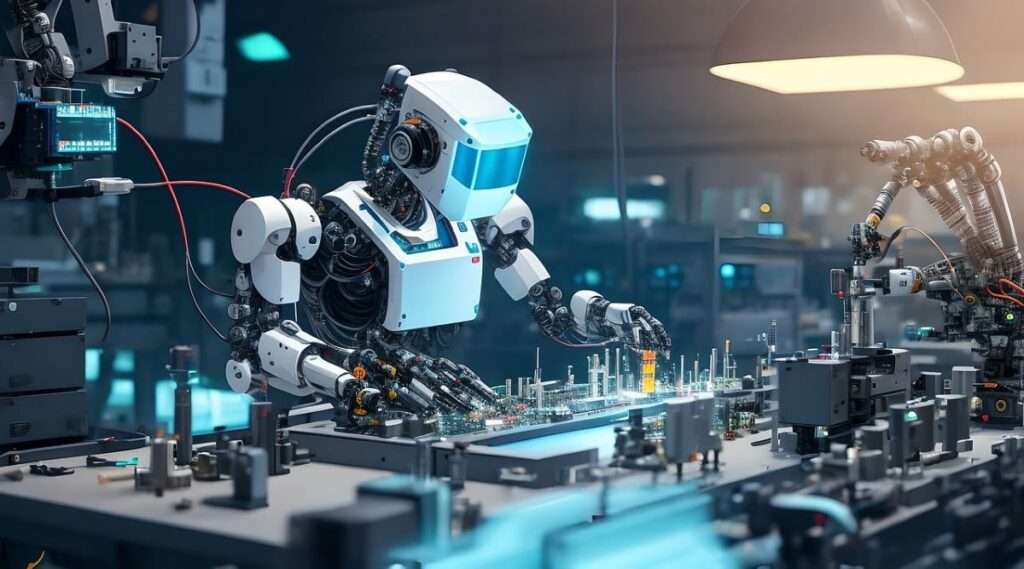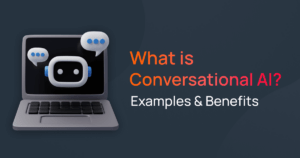Finding real-world examples and use cases of conversational AI is not challenging, as this technology is now widely used across various industries. Conversational AI, natural language processing (NLP), and natural language understanding (NLU) enable computers to understand and respond in human languages, addressing requests and questions.
In this article, we will explain conversational AI technology and provide you with several use cases of conversational AI being used in systems that are already up and running.
The Role of Conversational AI in Modern Communication
Conversational AI primarily enhances human-computer interaction using chatbots and AI assistants to mimic human conversation. This technology utilizes natural language processing (NLP) and natural language understanding (NLU) to understand and respond to human languages, achieving a degree of interaction previously modeled by the Turing Test—a benchmark for measuring a machine’s ability to exhibit intelligent behavior equivalent to, or indistinguishable from, that of a human.
As one of the important AI terms to learn, conversational AI’s goal is also to infuse interactions with authenticity, empathy, and cognitive intelligence, effectively and rapidly addressing user needs while building relationships.
The real value of conversational AI lies in its ability to communicate in human language effectively resolving customer issues and positively impacting different industries, such as banking, insurance, healthcare, and more.

Conversational AI Technologies
Conversational AI operates through a blend of natural language processing, natural language understanding, natural language generation (NLG), and machine learning (ML). The system is trained on copious amounts of data, including text and speech, enabling it to understand, process, and generate human-like dialogue.
NLP converts unstructured data into a structured format, allowing the AI to comprehend and understand human language. The AI continuously learns from these interactions, recognizing speech patterns, improving its responses, and enhancing its efficiency.
NLU, a subset of NLP, discerns the intent behind a user’s query, while NLG generates appropriate textual responses. By incorporating machine learning, the system evolves and refines its response quality over time and progresses towards more advanced AI systems like generative AI.
Components of Conversational AI
Natural Language Processing consists of four steps: Input generation, input analysis, output generation, and reinforcement learning. Unstructured data is transformed into a format that can be read by a computer, which is then analyzed to generate an appropriate response.
Underlying machine learning algorithms improve response quality over time as it learns. These four NLP steps can be broken down further below:
- Input Generation is the means by which the user delivers their communication through either voice or text.
- Input Analysis, which engages (if text-based) by means of natural language understanding, which is one element of natural language processing. This derives meaning and intent from the words. When the input is spoken, an AI voice bot with automatic speech recognition (ASR) is applied to make sense of the spoken words and convert them to language tokens for analysis.
- Dialogue Management is the response technology that allows natural language generation to answer a user’s query.
- Reinforcement Learning is responsible for learning and improving the application over time. This function analyzes user inputs to sharpen and reinforce the accuracy of the interaction and response.
Conversational AI applications can be programmed to reflect different levels of complexity. This allows for variegated end products—such as personal voice assistants—to carry out interactions between customers and businesses, and to automate many human resources processes and activities within businesses.
Conversational AI in Action: Automation and ASR
Automatic Speech Recognition (ASR) is fundamental to conversational automation, enabling spoken language to be identified by the application. If the AI cannot recognize human speech and comprehend and understand the intent of what a speaker is saying, then an appropriate response becomes just an aspirational pipe dream.
ASR’s acoustic models analyze phonemes (which are perceptually distinct units of sound, for example, p, b, d, and t in English) to decode words used by NLP to uncover intent. There are three stages to this:
- Sound waves created by the speaker using a device
- Volume normalization to minimize background noise
- Breakdown of sound waves into phonemes, which are connected via analytical models to interpret the spoken words and give meaning to the input.
Alphanumerical characters present a challenge, as they can “sound” similar and make spelling out email addresses or even phone calls or numbers difficult, with a high rate of misunderstanding. But progress is ongoing.

Conversational AI Benefits
Who wouldn’t admire the awesome science and ingenuity that went into conversational artificial intelligence? But the most powerful motivator of progress has been the pragmatic, bread-and-butter benefits of technology.
High conversational AI ROI pays off tremendous cost efficiency, enterprise-wide as it delivers rapid responses to busy, impatient users, and also educates via helpful prompts and insightful questions.
Well-engineered, fully implemented, and personalized, conversational AI spreads to customer satisfaction at every level, from the budget-conscious CFO all the way through HR, IT, and other departments rescued from the drudgery of mundane, repetitive tasks.
Enhancing Business Growth and Efficiency
Thanks to mobile devices, businesses can increasingly provide real-time responses to end users around the clock, ending the chronic annoyance of long call center wait times.
And while a human worker can spot and offer to upsell and cross-sell opportunities, so can a properly trained virtual assistant—improving conversion rate from lead to purchase.
By asking tested, tailored questions, can pique customer interest and support sales team efforts through the funnel. Simply satisfying a mundane customer request often manifests in loyalty and referrals.
Scaling Operations Seamlessly
Being so scalable, cheap, and fast, Conversational AI relieves the costly hiring and onboarding of new employees. Quickly and infinitely scalable, an application can expand to accommodate spikes in holiday demand, respond to new markets, address competitive messaging channels, or take on other challenges.
Conversational AI solutions also can help triage and divert customer service inquiries so human agents can apply their training to more complex concerns.
Availability: On Duty 24/7/365
Customer service can be a money pit. For example, availability to address issues outside regular office hours in a global landscape sets up a tough choice between paying overtime or potentially losing a customer or employee.
But AI Customer Service, specifically conversational AI, slashes the OpEx around salaries and training (a particular benefit for SMBs) and this AI Assistant with conversational AI power never loses patience over a difficult issue or a hard-to-please user.
Consistency is another benefit. Since most of human interactions seeking support are repetitive and routine, it becomes simple to program an AI Assistant with conversational AI power to handle popular use cases. This availability and continuity are fuel for the vaunted customer experience.
Meanwhile, professional agents are free to participate in more complex queries and help build out their resumes and careers.
Empowering the Contact Center
Conversational AI is behind the scenes of every contact center automation, customer sentiment analytics, and customer service automation applications.
Every dissatisfaction with the implementation of contact center technology can impact the customer experience and eventually the company brand. Yet, transformation to ever more efficient and cost-effective models is inevitable. Meanwhile, it’s important to avoid having Artificial Intelligence become only a barrier for users to “game through” to reach a human agent quickly.
Conversational AI is constantly progressing toward initiating and leading customer interactions, with humans only supporting the conversation flow as needed. By investing in conversational AI along with customer journeys and creating meaningful user experiences, you strengthen loyalty and provide greater value to your brand name.
Conversational AI in Various Industries
Today’s customers demand quick, easy service experiences across the industry spectrum. Aisera’s feature-comprehensive and advanced self-service automation combines conversational AI technology and conversational automation into one SaaS cloud offer for both IT Service Desks and customer service chatbots. See the key benefits here for each business type:
Financial Services & Fintech
Leveraging conversational AI in banking and financial services has become very common these days. To highlight the key benefits of conversational AI in financial services, we can note the following
- Broaden the scope and efficiency of self-serve options by leveraging AI in fintech
- Improve personalization and streamlining of the banking experience
- Speed resolution across the omnichannel
Insurance
Conversational AI in insurance transforms interactions, offering more responsive and tailored customer service.
- Conversational AI streamlines the claims process, allowing customers to file claims quickly and effortlessly through conversational interfaces.
- Enhanced Customer Support: Provides round-the-clock responses to inquiries about policies, coverage details, and claim statuses, enhancing customer satisfaction.
- Personalized Policy Recommendations: Delivers customized insurance products based on individual customer data, increasing conversion rates.
- Operational Efficiency: Reduces operational costs by automating routine customer interactions, freeing up human agents for more complex tasks.
Healthcare and Medication
Conversational AI in Healthcare revolutionizes the industry by improving patient engagement and streamlining administrative tasks.
- Symptom Assessment and Triage: AI-powered chatbots provide initial symptom assessment and guide patients to the appropriate care based on their inputs.
- Appointment Scheduling: Automates the scheduling process, allowing patients to book, reschedule, or cancel appointments effortlessly.
- Personalized Health Reminders: Sends tailored reminders for medication, appointments, and preventive care, improving patient adherence to treatment plans.
- 24/7 Patient Support: Offers continuous support for patient inquiries, reducing wait times and improving patient experience.
- Access to Medical Information: Provides patients with instant responses to common health questions, reducing unnecessary doctor visits and empowering patients with information.
Telecommunications
- Optimize and improve customer satisfaction
- Raise per-agent support productivity
- Simplify workflows and escalation procedures
- Enable robust data collection
Airlines & Travel
- Drastically reduce customer support costs
- Deploy more human agents to non-standard requests
- Mitigate and reduce churn during challenging times
- Save costs by smoothly handling refunds, flight changes, and other requests
E-commerce
- Improve landing page conversion rates
- Reduce costs of acquisition
- Increase average order size via customer education
- Drive repeat purchases through smart follow-up
- Retain customers and drive loyalty
SaaS Industries
- Raises the quality of customer support solutions for greater CX
- Delivers responses effortlessly across the omnichannel in text or speech
- Self-educates through machine learning and improves the application over time
- Self-corrects and provides increasing quality responses in future interactions

Conversational AI Examples and Use Cases
Limited or “Weak AI,” also known as narrow AI is the commonest type: customer support, omnichannel deployment, and even Alexa, Siri, and Watson are considered limited because they focus on a very confined span of very specific tasks only. Strong AI, on the other hand, attempts to utilize human-like consciousness to address a broad range of problems.
Even with comparatively rudimentary problem-solving skills, conversational AI can save time and cost, improve cost efficiency and solve most customer interactions. Someday, however, Artificial superintelligence (ASI), with self-aware consciousness, will surpass what we can do today. And that doesn’t mean a sci-fi scenario out of Westworld!
Rather, think of capabilities like sophisticated robotics-enabled surgeries in remote or underserved areas; a dramatic reduction in healthcare costs; with better outcomes: all are imminent possibilities. Think of unlocking unusable documents at scale; autonomous driving; shipping of goods worldwide with minimal human intervention, and other breakthroughs. Think of robo-advisors for financial transactions that take algorithmic trading to levels we cannot currently imagine.
Down-to-earth examples of today’s Conversational AI use cases include:
- Online customer support relieves human agents of onerous tasks as mentioned above, saving money and morale
- Accessibility that reduces entry barriers to assistive technology users, including text-to-speech dictation and language translation
- HR processes that streamline employee training, onboarding, password changes, and updating employee personal information
- Healthcare efficiency improvements that help make services more accessible and affordable while easing and speeding claims processing
- Internet of Things (IoT) devices that use automated speech recognition to interact with end users. As we’ve mentioned, we now enjoy Amazon Alexa, Apple Siri, and Google Home, but watch for these to sprout new capabilities
- Computer software that we all use and appreciate, such as spellcheck.
The obvious example of leveraging conversational AI in our daily lives is using speech-based assistants like Amazon Alexa and Google Home millions of people
As a result, messaging and speech-based platforms are quickly displacing traditional web and mobile apps to become the new medium for interactive conversations. This overview of conversational AI will detail how this advanced technology works and how it is a driver for digital transformation for businesses.
As users worldwide become more dependent and accustomed to these platforms, it’s no surprise that enterprises are rapidly adopting conversational AI technology to keep up with user interests and demands. While the ultimate goal of deploying conversational AI platforms and these solutions is to revolutionize service experiences for customers and employees, it is important to know what conversational AI and Enterprise chatbots are, how they help brands differentiate themselves within the market, and how best to leverage them.
Conversational AI Technology Challenges
Conversational AI, though a relatively new technology in widespread business use, faces numerous challenges. These include handling diverse language mechanics like dialects, accents, and background noise, which can complicate input processing. Moreover, emotional nuances and slang can hinder the accurate interpretation of user intents.
The comparison of conversational AI vs generative AI indicates Gen AI possesses broader capabilities and is increasingly utilized across various industries. However, conversational AI systems are susceptible to security risks as they must collect and analyze data to respond to queries. Establishing robust privacy and security measures is crucial to maintaining user trust.
Additionally, while conversational AI can handle many tasks, it may struggle with complex or unexpected queries, necessitating a seamless handover to human agents to ensure customer satisfaction. Businesses must also consider the workforce implications of automating tasks with AI, supporting displaced employees through training and other resources to manage transitions effectively.
The Future of Conversational AI
Today, instant availability and accessibility matter more than ever. Digital businesses are no exception to this. As more and more users now expect, prefer, and demand conversational self-service experiences, it is crucial for businesses to utilize conversational AI and even upgrade to generative AI platforms, to survive and thrive within the market.
Following are expert predictions from Gartner about how AI will transform digital businesses in the next five years:
“By 2022, 70% of white-collar workers will interact with conversational platforms daily (Gartner). $3.9 trillion projected AI-derived business value growth by 2022” (Gartner).
“By 2023, 30% of customer service organizations will deliver proactive customer services by using AI-enabled process orchestration and continuous intelligence” (Gartner).
“By 2024, AI will become the new user interface by redefining user experiences where over 50% of user touches will be augmented by computer vision, speech, natural language, and AR/VR” (IDC Report).
“By 2025, customer service organizations that embed AI in their multichannel customer engagement platform will elevate operational efficiency by 25%” (Gartner).
Spotlight on Aisera’s Generative AI and Conversational AI Platform
Aisera offers the most feature-comprehensive and best conversational AI platform in the market, which blends AI virtual assistant technology, cognitive search, and AI workflow automation into one SaaS cloud offer for IT Service Desk and Customer Services. Book a free demo today!
Why Choose Aisera?
Aisera delivers AI Service Management (AISM) solutions that leverage generative AI and advanced Conversational AI and automation to provide an end-to-end Conversational AI Platform. These advanced AI capabilities automate tasks, actions, and workflows for ITSM, HR, Facilities, Sales, Customer Service, and IT Operations.
Now businesses can deliver greater real-time self-service resolutions through consumer-like service experiences for employees and customers. Digital acceleration and transformation for conversational interfaces are achieved in seconds with Aisera. Book a custom AI demo today!
FAQs
What is the difference between conversational AI and Chatbot?
What are the types of conversational AI?
- Chatbots: Simple, rule-based AI that responds to specific inputs.
- Intelligent Virtual Assistants (IVA): Advanced AI using natural language processing and machine learning for more flexible responses.
- Mobile Assistants: a type of conversational AI specifically designed to be used on smartphones and other mobile devices.

